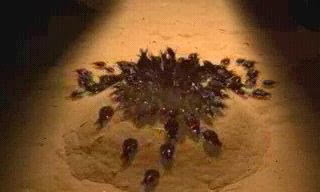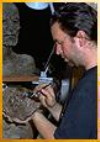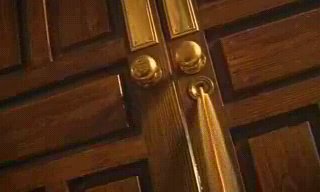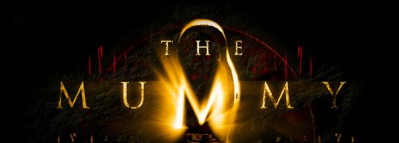
A large-scale, big-screen production such as
Universal Pictures' new and ambitious version
of the 1932 classic, The Mummy, requires a
vast amount of effects filming. This included
state of the art visual effects, supervised by
Industrial Light and Magic's John Berton, the
live action creature effects under the
supervision of Nick Dudman, and the special effects, supervised by
Chris Corbould.
John Berton, ILM's visual effects supervisor on The Mummy, was
given the daunting task of overseeing the film's numerous visual
effects sequences-many which involved the Mummy itself.
Berton says, "We first had to figure out what the Mummy would be
like and we knew we wanted him to be totally unique, we didn't want
him to be just a guy in bandages. He had to be mean, tough, nasty,
something that had never been seen by audiences before."
 "It took us about three months to develop the
look," Berton says. "This was before filming
started because we had to plan the effects and,
until we knew what the Mummy was, we couldn't
plan how to make him real. All those things are
very much intertwined and there's a certain kind of
synthesis that goes on in terms of thinking how
you would do it as opposed to thinking about how
it will look."
"It took us about three months to develop the
look," Berton says. "This was before filming
started because we had to plan the effects and,
until we knew what the Mummy was, we couldn't
plan how to make him real. All those things are
very much intertwined and there's a certain kind of
synthesis that goes on in terms of thinking how
you would do it as opposed to thinking about how
it will look."
From the very beginning, Berton felt that 'motion capture,' which is a
construction of motion information, was the best way to go. While
motion capture doesn't have the same expressiveness as animation,
it does provide for a tremendous amount of realism.
Berton says, "In this case we tried to achieve realistic motion. We
were not trying to make a magical Mummy, we were trying to make
a menacing and very realistic Mummy, and human motion is
incredibly difficult to do because we all know what it looks like. We
all know exactly how a human being moves. And if it's not right, you
are going to see it right away."
The best way to create the natural movements
of the Mummy was through simple observation,
one of the basic necessities of good animation.
"Not only do we have all the witness cameras
recording the 'Motion Capture'", Berton says.
"But we also poured over all the other
photography that was done on Arnold. We also
did some specific photography of Arnold so that we understood what
his gait was and other things about the way he moved and how that
worked in three-dimensional space.
 There were two techniques that were used to create the Mummy. In
the Mummy's earlier stages he was completely synthetic. But when
he begins to look more like Arnold, Berton used combinations of live
action and computer graphics of Imhotep. They then had to match
what were essentially digital prosthetic make-up pieces on to
Arnold's face.
There were two techniques that were used to create the Mummy. In
the Mummy's earlier stages he was completely synthetic. But when
he begins to look more like Arnold, Berton used combinations of live
action and computer graphics of Imhotep. They then had to match
what were essentially digital prosthetic make-up pieces on to
Arnold's face.
Berton says, "As Imhotep, Arnold obviously brings a tremendous
amount of live action presence to the film. When you see his film
image, that's him. When he turns his head and half of his face is
missing and you can see right through on to his teeth, that's really
his face. And that's why it was so hard to do."
Berton was persistent in stressing that he didn't want people to
know how the effects were accomplished, as he considers it a
failure when people are more concerned with the visual effects than
they are with the film. The staff at ILM wanted to make sure that the
work they did served the film and didn't really point to itself.
Corbould, whose work on the James Bond films has established him
as one of the world's top special-effects artists, is very enthusiastic
about the overall effects work on The Mummy.
Corbould says, "From a special effects point of view, The Mummy is
quite a big picture. We've gone for quality on this film as opposed to
quantity. I had to satisfy Stephen's vision and make it work for the
ILM set-up, which was quite tricky at times."
 "This film, which utilizes the very best of present day state-of-the-art
technology, will be recognized around the world as the epitome of
an effects movie," he claims. "When I first read Stephen's script, I
was struck by the tremendous potential for creating sequences that
had not before been seen in action-adventure movies."
"This film, which utilizes the very best of present day state-of-the-art
technology, will be recognized around the world as the epitome of
an effects movie," he claims. "When I first read Stephen's script, I
was struck by the tremendous potential for creating sequences that
had not before been seen in action-adventure movies."
Sommers says, "I always wanted the Mummy to be computer
generated. Prosthetics, used properly, are great but you can't
always rely on them. And I knew if I was going to make The Mummy
in the 1990's it couldn't just be a guy wrapped in bandages. It had to
blow people's socks off...so I knew straight away we had to go with
modern computer technology."
As Make-Up Effects Supervisor, Nick Dudman was called upon to
lend his considerable expertise to producing all the actual physical
creature effects in The Mummy, which included three-dimensional
make-up and prosthetics. A veteran of numerous George Lucas
films, including Star Wars: Episode I - The Phantom Menace,
Dudman was also tasked with designing all the animatronic effects
in the film.
Other key special effect sequences in The Mummy included the
enormous fire aboard the passenger barge, both below and above
decks; the fire and hail storm in the courtyard of the British Fort; the
face of the Mummy in the desert sand; a barrage of explosions as
thousands of Tuareg horsemen attack a garrison of Legionnaires in
the Sahara Desert; and a crashed World War II plane sinking nose
first into the desert sand.
 Corbould adds, "The CGI (Computer Generated Images) element in
The Mummy are pretty paramount. There were so many visual
effects required by the story that would be impossible for us to
achieve and ILM was creating things we couldn't create. Normally in
a film, visual effects would be enhancing something that we were
doing but in The Mummy we were enhancing their work."
Corbould adds, "The CGI (Computer Generated Images) element in
The Mummy are pretty paramount. There were so many visual
effects required by the story that would be impossible for us to
achieve and ILM was creating things we couldn't create. Normally in
a film, visual effects would be enhancing something that we were
doing but in The Mummy we were enhancing their work."
"There were a number of smaller effects which presented more of a
challenge. One example was the sand coming through keyholes as
the Mummy materializes. When you read the script you think it's
easy; just pour sand through the keyhole. But it doesn't work like
that, especially when Steve wants a big volume of sand. We ended
up pressurizing it.
However, all this meant that a considerable amount of work on the
film would have to take place in post-production, which presented
quite a challenge for the actors.
FFraser says, "Because of the amount of visual effects in the movie,
there were many scenes where we found ourselves acting, or
reacting, to nothing in front of us. In situations like that I guess you
rely on the thing you're asked to call upon in the first place...your
imagination."
When a scene called for the actors to show fear or terror in their
reactions, the crew would hold up a photograph of how Arnold
Vosloo looks as the Mummy, as a source of inspiration.
Weisz says, "It certainly improved my imagination because Stephen
would suddenly say: 'Alright, in front of you is a huge chariot
crashing down the stairs with 10,000 armed soldiers rushing straight
at you.' But there was nothing there at all, so I had to create the
correct emotion, fear or whatever, while just looking at a blank
space."
To ascertain the safety of the actors, the special effects team
worked closely with the stunt team, conducting numerous tests with
stunt personnel before actually filming a sequence. And in the end,
the production proceeded without any major bumps, resulting in a
relatively smooth production for a project the size and scope of The
Mummy.
Information From

 "It took us about three months to develop the
look," Berton says. "This was before filming
started because we had to plan the effects and,
until we knew what the Mummy was, we couldn't
plan how to make him real. All those things are
very much intertwined and there's a certain kind of
synthesis that goes on in terms of thinking how
you would do it as opposed to thinking about how
it will look."
"It took us about three months to develop the
look," Berton says. "This was before filming
started because we had to plan the effects and,
until we knew what the Mummy was, we couldn't
plan how to make him real. All those things are
very much intertwined and there's a certain kind of
synthesis that goes on in terms of thinking how
you would do it as opposed to thinking about how
it will look."
 "This film, which utilizes the very best of present day state-of-the-art
technology, will be recognized around the world as the epitome of
an effects movie," he claims. "When I first read Stephen's script, I
was struck by the tremendous potential for creating sequences that
had not before been seen in action-adventure movies."
"This film, which utilizes the very best of present day state-of-the-art
technology, will be recognized around the world as the epitome of
an effects movie," he claims. "When I first read Stephen's script, I
was struck by the tremendous potential for creating sequences that
had not before been seen in action-adventure movies."
 Corbould adds, "The CGI (Computer Generated Images) element in
The Mummy are pretty paramount. There were so many visual
effects required by the story that would be impossible for us to
achieve and ILM was creating things we couldn't create. Normally in
a film, visual effects would be enhancing something that we were
doing but in The Mummy we were enhancing their work."
Corbould adds, "The CGI (Computer Generated Images) element in
The Mummy are pretty paramount. There were so many visual
effects required by the story that would be impossible for us to
achieve and ILM was creating things we couldn't create. Normally in
a film, visual effects would be enhancing something that we were
doing but in The Mummy we were enhancing their work."
